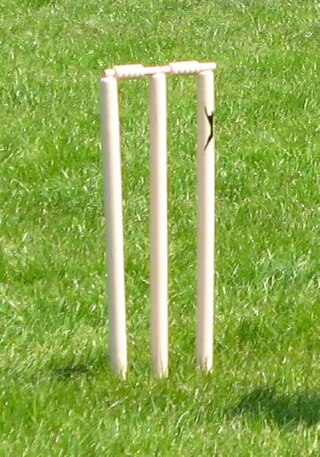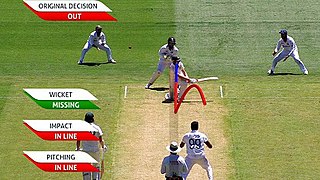
Bowling, in cricket, is the action of propelling the ball toward the wicket defended by a batter. A player skilled at bowling is called a bowler; a bowler who is also a competent batter is known as an all-rounder. Bowling the ball is distinguished from throwing the ball by a strictly specified biomechanical definition, which restricts the angle of extension of the elbow. A single act of bowling the ball towards the batsman is called a ball or a delivery. Bowlers bowl deliveries in sets of six, called an over. Once a bowler has bowled an over, a teammate will bowl an over from the other end of the pitch. The Laws of Cricket govern how a ball must be bowled. If a ball is bowled illegally, an umpire will rule it a no-ball. If a ball is bowled too wide of the striker for the batsman to be able to play at it with a proper cricket shot, the bowler's end umpire will rule it a wide.

Fielding in the sport of cricket is the action of fielders in collecting the ball after it is struck by the striking batter, to limit the number of runs that the striker scores and/or to get a batter out by either catching a hit ball before it bounces, or by running out either batter before they can complete their current run. There are a number of recognised fielding positions and they can be categorised into the offside and leg side of the field. Fielding also involves trying to prevent the ball from making a boundary where four "runs" are awarded for reaching the perimeter and six for crossing it without touching the grass.

Leg before wicket (lbw) is one of the ways in which a batter can be dismissed in the sport of cricket. Following an appeal by the fielding side, the umpire may rule a batter out lbw if the ball would have struck the wicket but was instead intercepted by any part of the batsman's body. The umpire's decision will depend on a number of criteria, including where the ball pitched, whether the ball hit in line with the wickets, the ball's expected future trajectory after hitting the batsman, and whether the batsman was attempting to hit the ball.
The Laws of Cricket is a code that specifies the rules of the game of cricket worldwide. The earliest known code was drafted in 1744. Since 1788, the code has been owned and maintained by the private Marylebone Cricket Club (MCC) in Lord's Cricket Ground, London. There are currently 42 Laws, which describe all aspects of how the game is to be played. MCC has re-coded the Laws six times, each with interim revisions that produce more than one edition. The most recent code, the seventh, was released in October 2017; its 3rd edition came into force on 1 October 2022.

The wicket-keeper in the sport of cricket is the player on the fielding side who stands behind the wicket or stumps being watchful of the batsman and ready to take a catch, stump the batsman out and run out a batsman when occasion arises. The wicket-keeper is the only member of the fielding side permitted to wear gloves and external leg guards. The role of the keeper is governed by Law 27 and of the Laws of Cricket.

In cricket, the term wicket has several meanings:

This is a general glossary of the terminology used in the sport of cricket. Where words in a sentence are also defined elsewhere in this article, they appear in italics. Certain aspects of cricket terminology are explained in more detail in cricket statistics and the naming of fielding positions is explained at fielding (cricket).

In cricket, a no-ball is a type of illegal delivery to a batter. It is also a type of extra, being the run awarded to the batting team as a consequence of the illegal delivery. For most cricket games, especially amateur, the definition of all forms of no-ball is from the MCC Laws of Cricket.

French cricket is a form of cricket that creates a game similar to catch. The game can be played socially at picnics and parties or on parks and beaches. It is a form of cricket that can include children of varied ages.

In cricket, batting is the act or skill of hitting the ball with a bat to score runs and prevent the loss of one's wicket. Any player who is currently batting is, since September 2021, officially referred to as a batter —regardless of whether batting is their particular area of expertise. Batters have to adapt to various conditions when playing on different cricket pitches, especially in different countries; therefore, as well as having outstanding physical batting skills, top-level batters will have quick reflexes, excellent decision-making skills, and be good strategists. Although batsman is still widely used.

In cricket, an extra is a run scored by, or awarded to, a batting team which is not credited to any individual batter. They are the runs scored by methods other than striking the ball with the bat.

In cricket, a dismissal occurs when a batter's innings is brought to an end by the opposing team. Other terms used are the batter being out, the batting side losing a wicket, and the fielding side taking a wicket. The ball becomes dead, and the dismissed batter must leave the field of play for the rest of their team's innings, to be replaced by a team-mate. A team's innings ends if ten of the eleven team members are dismissed. Players bat in pairs so, when only one batter remains who can be not out, it is not possible for the team to bat any longer. This is known as dismissing or bowling out the batting team, who are said to be all out.
Baseball and cricket are the best-known members of a family of related bat-and-ball games. Both have fields that are 400 feet (120 m) or more in diameter between their furthest endpoints, offensive players who can hit a thrown/"bowled" ball out of the field and run between safe areas to score runs (points) at the risk of being gotten out, and have a major game format lasting about 3 hours.

In cricket, a scorer is someone appointed to record all runs scored, all wickets taken and, where appropriate, the number of overs bowled. In professional games, in compliance with Law 3 of the Laws of Cricket, two scorers are appointed, most often one provided by each team.
Crocker is a team sport played between two large teams. Its origins are in cricket and baseball. It also makes the use of a rugby ball, or a soccer ball which may explain its name. It is a casual sport not played formally, but often found on British summer camps.

Bat-and-ball games are field games played by two opposing teams. Action starts when the defending team throws a ball at a dedicated player of the attacking team, who tries to hit it with a bat and run between various safe areas in the field to score runs (points). The defending team can use the ball in various ways against the attacking team's players to force them off the field when they are not in safe zones, and thus prevent them from further scoring. The best known modern bat-and-ball games are cricket and baseball, with common roots in the 18th-century games played in England.

The Decision Review System (DRS), formerly known as the Umpire Decision Review System(UDRS), is a technology-based system used in cricket to assist the match officials in their decision-making. On-field umpires may choose to consult with the third umpire (known as an Umpire Review), and players may request that the third umpire consider a decision of the on-field umpires (known as a Player Review).

The 1974–75 Ashes series consisted of six cricket Test matches, each match lasted five days with six hours of play each day and eight ball overs. It formed part of the MCC tour of Australia in 1974–75 and the matches outside the Tests were played in the name of the Marylebone Cricket Club. Ian Chappell's Australians won the series 4–1 and "brutally and unceremoniously wrenched the Ashes" from Mike Denness's England team. It was Australia's first series victory over England for ten years and the experience proved popular as 777,563 spectators came through the gates and paid nearly a million Australian dollars for the privilege. For the first time the first day of the Third Test at Melbourne was held on Boxing Day in an Ashes series, now a cricketing tradition.
Podex is a variety of cricket played in some public schools in the UK and on youth camps, most famously Crusader Camp and Houseparty at Bethany School, which has recently been classed as a Centre of Excellence of Podex. Unlike cricket it uses two instead of three stumps, and a bat rather like a rounders bat but more the length of cricket bat. A soft rather than a hard ball – a sorbo – is used. Kneale (2016) notes a variety in the rules of the game and suggests its origins lie in games played at camps organised by the Scripture Union prior to the First War.

The 2023 Ashes series, branded as the LV= Insurance Men's Ashes Series for sponsorship reasons, was a series of Test cricket matches played between England and Australia for the Ashes in June and July 2023. The five-match series was a part of the 2023–2025 ICC World Test Championship, the venues being Edgbaston, Lord's, Headingley, Old Trafford and The Oval.



















